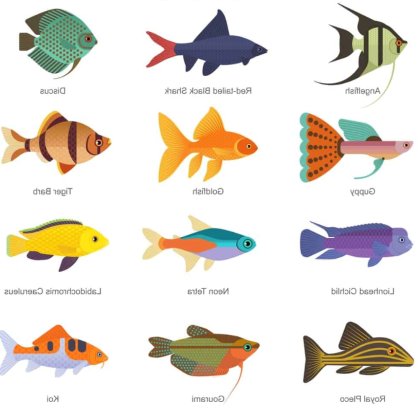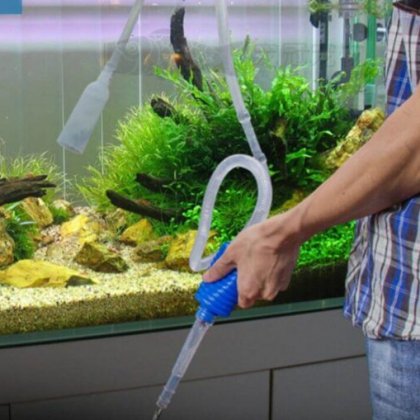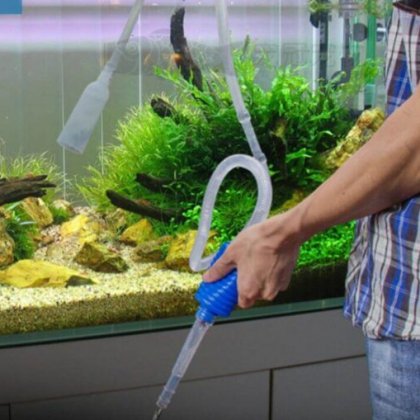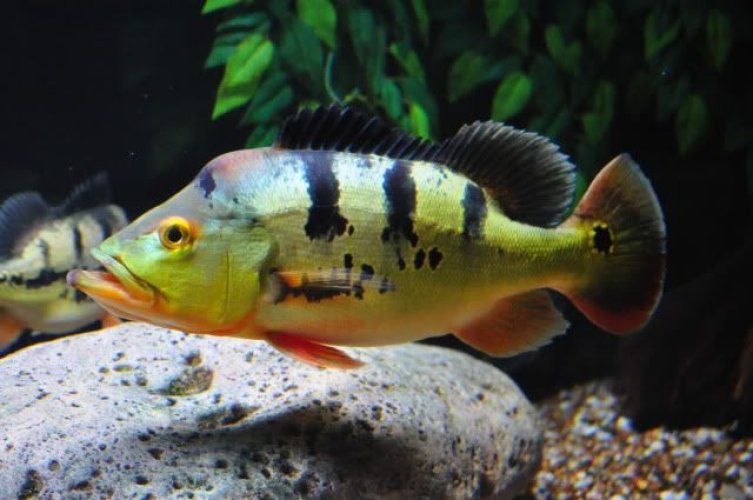Orinoco Peacock Bass Aquarium Care, Feeding and Native Habitat Information
Orinoco Peacock Bass are named for the Orinoco river of Venezuela and Colombia, from which they originate. Like other Peacock Bass species, Orinoco Peacock Bass are found living in relatively strong flowing Amazonian rivers where they use the cover of branches, driftwood and plant vegetation to ambush a wide variety of prey items. The waters of their native Orinoco river are very warm year round with temperatures reaching upwards of 86 ° when the sun is at its peak, and with nighttime temperatures still hovering around the 80 ° mark. Orinoco river waters conditions are acidic with a pH range of 5.0 to 6.5 and a water hardness between 5 to 15 dH; as well as, fast flowing with a large volume of water passing down from the mountains on its way to the ocean. Cichla orinocensis have evolved perfectly for their environment with long sleek bodies and powerful pectoral and anal fins, which they use to maintain ambush positions in rapidly flowing waters and ambush prey. Orinoco Peacock Bass are becoming much more available within the aquarium hobby as their size, pattern, coloration and aggressive feeding habits have made them very popular with aquarium hobbyists interested in keeping larger New World Cichlid species.
When keeping Orinoco Peacock Bass in an aquarium environment, it is important to account for their large size, feeding habits and aggressive nature. Orinoco Peacock Bass come from river ways that have a constant flow of fresh water working from the mountains down to the sea. Peacock Bass have become accustomed to an environment with high quality water with low levels of pollutants and high levels of oxygen. Orinoco Peacock Bass aquariums need to replicate this environment through strong mechanical, chemical and biological filtration along with medium to strong water movement. Peacock Bass are large fish that eat equally large meals, thus excellent filtration is required to remove the excess food and waste products produced from such a large species. The adult size of the Orinoco Peacock Bass is also an important factor in choosing the right aquarium to house them, with the size and shape of the aquarium being very important. With adults sizes of around 2 feet in length, it is important to provide an aquarium that is long enough and wide enough from front to back to allow the Peacock Bass to swim and turn around comfortably. An aquarium of 6 to 8 feet in length and 3 feet from front to back should be considered as minimum aquarium size for an adult specimen, while smaller specimens can be raised in smaller aquariums if they are moved to larger tanks as they grow. The aquarium decor should be designed to provide plenty of swimming room, while also providing some areas of cover using driftwood, floating or well rooted plants and rocks with a sandy or gravel substrate.
Tank mates are an important consideration when housing adult Peacock Bass with other New World Cichlids due to their large size and aggressive temperament. A good rule of thumb is that anything that can fit in the mouth of the Peacock Bass eventually will. Tank mates should consist of other large aggressive New World Cichlids, large Catfish species and freshwater rays. Orinoco Peacock Bass can be kept as the only Peacock Bass species or mixed with other species of Peacock Bass. They also do well in good sized groups and will work out a dominance structure amongst themselves, which will lower aggression between fish once their social hierarchy is in place.
Wild Orinoco Peacock Bass feed on a wide variety of live foods living in their river ecosystem, which include: smaller fish, worms, crustaceans, insects and amphibians. Orinoco Peacock Bass kept within the aquarium environment will readily feed on the same variety of live foods that they feed on in nature, but it is often more desirable to ween them off of live foods. Live foods are typically more expensive, require holding tanks, more frequent trips to the aquarium store, can bring diseases and can create excess pollution in the aquarium water. Hobbyists generally ween their Peacock Bass to commercial food preparations in order to simplify their care and avoid the pitfalls or live foods. However, it is not uncommon for Peacock Bass enthusiasts who have weened their fish to commercial foods to provide the occasional live feeding to enjoy the prey drive and aggressive feeding technique of the Peacock Bass. Suitable commercial foods for Peacock Bass include: blood worms, pellet foods, food sticks, frozen meaty foods like krill, silver sides or similar fare. Peacock Bass will also consume a variety of dead meaty foods like raw shrimp, raw fish and similar meaty items. Individual specimens will often have their own preferences, with some specimens eating most anything while others will be more picky about their diet.
No reviews found!































No comments found for this product. Be the first to comment!